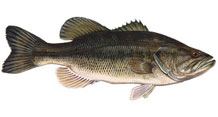Florida State Freshwater Fish- Largemouth Bass
Largemouth Bass

This fish has lateral horizontal stripes along the body, and these serve to be motion detectors so that they can easily find their prey, this fish is considered to be a predator where it can consume other fish, frogs, Cray fish, this fish also has the ability to swallow small animals.
The female fishes are capable of laying a million eggs during the periods of spawning. People tend to use this fish for leisure fishing. The major reason for this activity is that these fishes are present in abundance. And this fish can be caught very easily. And since the fish supports recreational activities, many people are attracted towards fishing and this increases the economy of the state. But then the introduction of these fishes in to other water bodies has affected the ecosystem, as these fishes are fast predators and they consume other smaller species very quickly.
Physical Description:
Largemouth bass is a olive green fish with series of dark and black blotches forming a jagged horizontal stripe along flank. The upper jaw called maxilla of a fish extends beyond the rear margin of the orbit. Largemouth is the largest of black basses with maximum length of 29.5 in 75 cm and recorded weight of 25 pounds 1 ounce. This fish lives 16 years on average.
Forage:
The juvenile largemouth bass normally consumes small bait-fish, scuds, small shrimp and insects. Adult's largemouth consumes smaller fish, crawfish, frogs, snakes, salamanders, bats and baby alligators. All prey items can be as large as 25 to 35% of the bass's body length. Less weed cover allows bass to more easily find the prey. Fisheries managers need to keep all factors when designing regulations for bodies of water. Adult largemouths normally are apex predators within their habitat, but they are preyed upon by many animals while young.
Angling:
Largemouths are keenly noted for the excitement of their fight. The fish will often become airborne in their effort to throw the hook and smallmouth bass can beat them pound for pound. Anglers most often look for largemouth bass with lures such as plastic worms, jigs, crankbaits and spinner baits. A recent trend is the use of large swimbaits to point trophy bass that often forage on juvenile rainbow trout in California Live bait, such as nightcrawlers, minnows, frogs or goldfish, can also be helpful. Large golden shiners are best things to use to catch trophy bass, especially when they are sluggish in the heat of summer time or in the cold of winter.
The Largemouth Bass has been known to exist in many of the lower 48 states of the U.S. The International Game Fish Association (IGFA) authoritatively recognizes the heaviest largemouth bass on record as having been caught by George Perry at Montgomery Lake in Telfair County, Georgia.












